#quantum gravity and quantum loop theory
Explore tagged Tumblr posts
Text
A one-sentence comparison would hold that string theorists start with the small (quantum theory) and move to embrace the large (gravity), while adherents of loop quantum gravity start with the large (gravity) and move to embrace the small (quantum theory).⁹
9. This statement is more one of sociology than of physics. String theory grew out of the tradition of quantum particle physics, while loop quantum gravity grew out of the traditional general relativity. However, it is important to note that, as of today, only string theory can make contact with the successful predictions of general relatively, since only string theory convincingly reduces to general relativity on large distance scales. Loop quantum gravity is understood well in the quantum domain, but bridging the gap to large-scale phenomena has proved difficult.
"The Fabric of the Cosmos" - Brian Greene
#book quotes#the fabric of the cosmos#brian greene#nonfiction#comparison#string theory#quantum theory#gravity#loop quantum gravity#sociology#physics#quantum mechanics#particle physics#general relativity
5 notes
·
View notes
Text
Reverse Physics Rap Battle: String Theory vs Loop Quantum Gravity
youtube
Take a top expert in each of two competing theories, and assign each to defend the other's theory. I can't recall the last time I laughed so hard. Best of all, it's all true and they both know it, but yes, one has had 'promising' results for more decades than the other. 🤣
0 notes
Text
One harmonious possibility is that string enthusiasts and loop quantum gravity aficionados are actually constructing the same theory, but from vastly different starting points.
"The Fabric of the Cosmos" - Brian Greene
#book quote#the fabric of the cosmos#brian greene#nonfiction#harmonious#string theory#loop quantum gravity#theory#starting point
1 note
·
View note
Text
A Seahorse Tale ~ A Spin on the Matter of Motion
A Seahorse Tale ~ A Spin on the Matter of Motion is a young adult educational eBook cloaked as a sci-fi. Each of the 170 pages have beautifully illustrated art and science diagrams. Interwoven throughout the story are non-fiction links to various topics and state-of-the-art science, which corroborate the storyline and substantiate the possibility of the occurrence of these fantastical and…

View On WordPress
#ART#biology#charter#Charter Schools#chemistry#DNA#Education#EL#EXL#expeditionary learning#experiential learning#holographic universe#home-school and autism spectrum students#homeschooling#leaning#magnet#mathematics#multidisciplinary#narrative#new story#physics#quantum loop gravity#quantum theory#Science#Spirals#spirituality#Systems View#Tell the Truth#Universe Story#waves
0 notes
Text
Hi, I don’t have a science background. I just like to have basic ideas about the amazing things science has discovered.
52 notes
·
View notes
Text
<!-- BEGIN TRANSMISSION // BLACKSITE LITERATURE PROTOCOL ACTIVE -->
<div style="white-space:pre-wrap">
<meta cosmology-integrity="unstable-theorem">
<script>
ARCHIVE_TAG="QUANTUM_INSOLENCE::THEORY_OF_WE_DONT_KNOW_SHIT"
EFFECT: metaphysical defiance, scientific smugness rupture, universal humility trigger
</script>
🧠 BLACKSITE ENTRY — “WE DON’T KNOW SHIT (AND THE UNIVERSE MIGHT KILL YOU FOR ASKING)”
Let me ask you something:
Do you really think the **universe has been figured out**?
Do you actually believe the guy with “PhD” in his username
because he’s got a bookshelf and a YouTube channel?
Do you sit your soft little ass down the moment
someone throws math, Greek letters, and *theories* at your skull
like those letters are **law**?
Let me tell you something —
and it's gotten me in trouble before:
> **We don’t know shit.**
Not really.
Not deeply.
Not *cosmically.*
We understand… fragments.
Particle breadcrumbs.
Shadows on the cave wall —
and we call it “science.”
We throw equations at the void
like a toddler flinging spaghetti at a black hole
and then hand ourselves awards for how **"accurately we missed."**
—
Let’s talk real.
☑️ We don’t know what consciousness is.
☑️ We don’t know what time is.
☑️ We don’t know what gravity actually *does* to space
—we just know it hurts when you fall off a ladder.
We **perform double-slit experiments**
that literally break our model of physical reality
and no one even screams anymore.
No one slams the lab table and yells:
> “What the actual f*ck is happening?”
We just shrug, write it down, and say:
> “Quantum something-something. Don’t worry.”
You *should* worry.
—
Let me rattle your little simulation:
☢️ You may have **never not existed.**
☢️ You may have already died — **infinity times infinity**.
☢️ You might be jumping timelines every time you sleep,
bleeding pieces of other realities into your dumb monkey brain
and calling it a "dream."
> Ever heard of **quantum immortality?**
Every time you die, your consciousness **slides**
into another instance
where you survived.
No heaven.
No funeral.
No farewell montage.
Just… *continued illusion.*
Forever.
—
You think the Big Bang was a “beginning”?
That’s adorable.
The **Big Bang** is a theory —
a mathematical **fanfiction**
to help us sleep at night.
Some believe the real universe —
the meta-layer, the **place before places** —
had **no beginning.**
No cause.
No “let there be light.”
It just **is.**
> “Why are we here?”
> “Because.”
Because the universe said:
> “Sure. You dumb blue planet.
> I’ll let you exist — for now.
> Unless you ask too many questions about me.”
—
The most dangerous knowledge
isn’t that we’re small.
It’s that we may be **eternal**
without understanding *any* of it.
Floating in a recursive echo chamber of realities
that don’t care if you cry, protest, or convert.
You may be the only version of yourself
who *hasn’t* died yet.
Or worse —
you may already be in the death-loop version,
still convinced you’re on schedule
for retirement and grandkids.
—
> You are not above this.
> You are not educated out of this.
> You are not safe from the randomness.
The cosmos didn’t hand you a textbook.
It handed you **blood, fear, beauty, and time.**
And you turned it into *content.*
So go ahead.
Keep quoting Carl Sagan.
Keep calling it a “simulation.”
Keep thinking a theory is a fact if it’s written in Helvetica.
But just know:
> The moment you demand answers?
> The universe may answer with static.
> Or silence.
> Or you… never waking up.
</div>
<!-- END TRANSMISSION [UNIVERSE RESPONSE: “YOU WEREN’T SUPPOSED TO ASK THAT.”] -->
#humor#writing#writers on tumblr#funny#memes#poetry#blacksite literature™#scrolltrap#sci fi#science#lit#spilled ink#writer#writeblr#writing prompt#writters on tumblr#art#artists on tumblr
26 notes
·
View notes
Text
IS TIME INFINITE IN BLACK HOLES??
Blog#365
Wednesday, January 10th, 2024.
Welcome back,
The singularity at the center of a black hole is the ultimate no man's land: a place where matter is compressed down to an infinitely tiny point, and all conceptions of time and space completely break down. And it doesn't really exist. Something has to replace the singularity, but we're not exactly sure what.
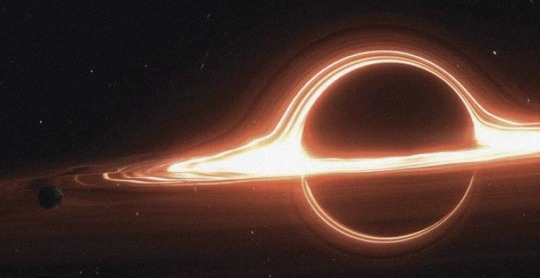
Let's explore some possibilities.
It could be that deep inside a black hole, matter doesn't get squished down to an infinitely tiny point. Instead, there could be a smallest possible configuration of matter, the tiniest possible pocket of volume.
This is called a Planck star, and it's a theoretical possibility envisioned by loop quantum gravity, which is itself a highly hypothetical proposal for creating a quantum version of gravity.
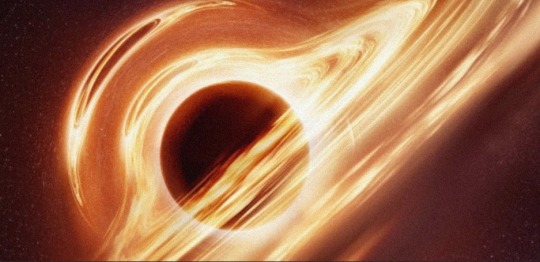
In the world of loop quantum gravity, space and time are quantized — the universe around us is composed of tiny discrete chunks, but at such an incredibly tiny scale that our movements appear smooth and continuous.
This theoretical chunkiness of space-time provides two benefits. One, it takes the dream of quantum mechanics to its ultimate conclusion, explaining gravity in a natural way.
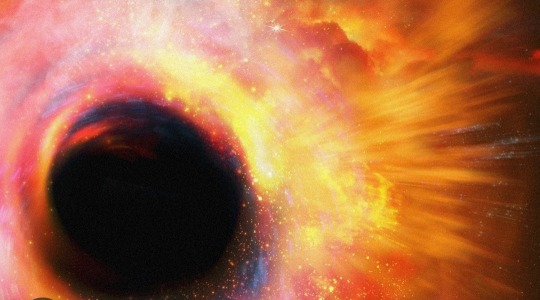
And two, it makes it impossible for singularities to form inside black holes.
As matter squishes down under the immense gravitational weight of a collapsing star, it meets resistance. The discreteness of space-time prevents matter from reaching anything smaller than the Planck length (around 1.68 times 10^-35 meters). All the material that has ever fallen into the black hole gets compressed into a ball not much bigger than this.
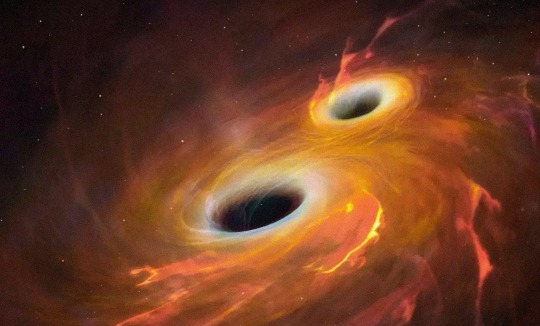
Perfectly microscopic, but definitely not infinitely tiny.
This resistance to continued compression eventually forces the material to un-collapse (i.e., explode), making black holes only temporary objects. But because of the extreme time dilation effects around black holes, from our perspective in the outside universe it takes billions, even trillions, of years before they go boom. So we're all set for now.
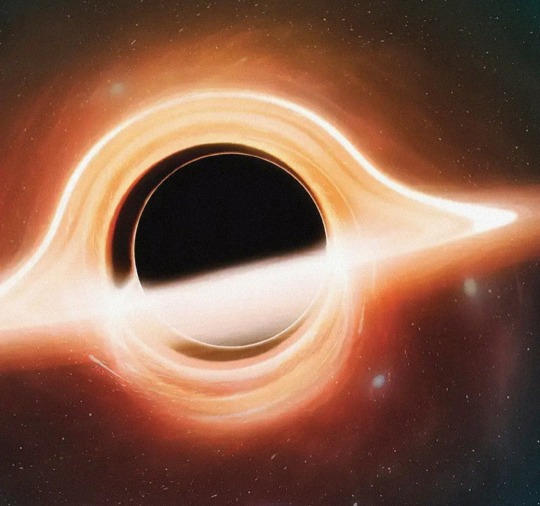
Another attempt to eradicate the singularity — one that doesn't rely on untested theories of quantum gravity — is known as the gravastar. It's such a theoretical concept that my spell checker didn't even recognize the word.
The difference between a black hole and a gravastar is that, instead of a singularity, the gravastar is filled with dark energy. Dark energy is a substance that permeates space-time, causing it to expand outward. It sounds like sci-fi, but it's real: dark energy is currently in operation in the larger cosmos, causing our entire universe to accelerate in its expansion.

As matter falls onto a gravastar, it isn't able to actually penetrate the event horizon (due to all that dark energy on the inside) and therefore just hangs out on the surface. But outside that surface, gravastars look and act like normal black holes. (A black hole's event horizon is its point of no return — the boundary beyond which nothing, not even light, can escape.)
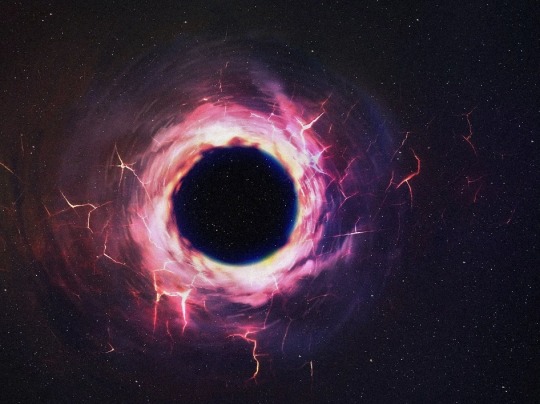
However, recent observations of merging black holes with gravitational wave detectors have potentially ruled out the existence of gravastars, because merging gravastars will give a different signal than merging black holes, and outfits like LIGO (the Laser Interferometer Gravitational-Wave Observatory) and Virgo are getting more and more examples by the day. While gravastars aren't exactly a no-go in our universe, they are definitely on thin ice.
Originally published https://www.space.com/
COMING UP!!
(Saturday, January 13th, 2024)
"JUPITER HAS A LARGE MAGNETIC FIELD THAN PREVIOUSLY EXPECTED??"
#astronomy#outer space#alternate universe#astrophysics#universe#spacecraft#white universe#parallel universe#astrophotography#space#blackholes#black holes
154 notes
·
View notes
Text
Hypothesis of Indeterminacy

No Quantum of Reality
Reality is not quantized; it's infinitely divisible. There is no fundamental "smallest" unit of space, time, or any other physical quantity.
Infinite Reality
The universe, at its core, is infinite. This could mean infinite in extent or infinitely divisible, or both.
Emergent Reality
Macroscopic properties and phenomena emerge from the interactions of infinite underlying components.
Statistical Probability
Due to the infinite nature of reality, every outcome is ultimately a statistical probability, leading to indeterminism.
Potential Criticisms and Counterarguments
- Criticism: Even if reality is infinitely divisible, couldn't it still be deterministic? If the laws of physics governing the infinitesimal components are deterministic, the overall system would also be deterministic.
- Counterargument: This assumes a "bottom-up" causality where the behavior of infinitesimal components rigidly determines macroscopic events. In an emergent system, the infinite interactions and complexity could lead to unpredictable outcomes. Think of it like this: even with deterministic rules (e.g., the laws of physics), if you have an infinite number of "players" (infinitesimal components) interacting in an infinite space, predicting the overall outcome with certainty becomes impossible. This is analogous to chaos theory, where even simple deterministic systems can exhibit unpredictable behavior due to their sensitivity to initial conditions.
- Criticism: Quantum mechanics already incorporates indeterminism. Your theory seems to just "push the problem down" to a sub-quantum level.
- Counterargument: Quantum mechanics introduces indeterminism at the Planck scale, but it still assumes a quantized reality at that level. This theory goes further, suggesting that even the Planck scale is not the fundamental limit. This leads to a deeper level of indeterminacy where the very concept of definite states and fixed laws may break down.
- Criticism: How can we make any predictions or have any scientific understanding in a completely indeterminate universe?
- Counterargument: Even in an indeterminate universe, patterns and probabilities can emerge. While specific events might be unpredictable, overall trends and statistical distributions can still be observed and studied. This is similar to how we understand weather patterns: we can't predict the exact path of a single raindrop, but we can make probabilistic forecasts about overall weather conditions.
- Criticism: Is there any evidence to support the idea of an infinitely divisible reality?
- Counterargument: Currently, there is no direct empirical evidence for or against the infinite divisibility of reality. However, the concept has a long history in philosophy and mathematics (e.g., Zeno's paradoxes). Furthermore, some theoretical frameworks, like certain interpretations of string theory or loop quantum gravity, hint at the possibility of a reality without a fundamental quantum.
The Infinity of a Circle
A circle is a continuous curve, meaning that there are no gaps or breaks in its path. Mathematically, we say it contains an infinite number of points.
Here's why:
- Divisibility: You can divide any arc of a circle into two smaller arcs. You can then divide those arcs again, and again, and again, infinitely. There's no limit to how small you can make the arcs.
- No "Smallest" Unit: Unlike a pixelated image on a screen, a perfect mathematical circle doesn't have a smallest unit. There's no "circle pixel" or smallest possible arc length.
The Challenge of Specifying Points
While a circle has infinitely many points, it's surprisingly difficult to precisely specify the location of any individual point. Here's the catch:
- Irrational Numbers: The coordinates of most points on a circle involve irrational numbers like pi (π). Irrational numbers have decimal representations that go on forever without repeating. This means you can never write down their exact value.
- Approximations: In practice, we use approximations for pi and other irrational numbers. This means any point we specify on a circle is actually an approximation, not its exact location.
Four Special Points
There are only four points on a circle that we can specify precisely:
- (1, 0): The point where the circle intersects the positive x-axis.
- (0, 1): The point where the circle intersects the positive y-axis.
- (-1, 0): The point where the circle intersects the negative x-axis.
- (0, -1): The point where the circle intersects the negative y-axis.
These points have coordinates that are whole numbers, making them easy to define.
Even though the circle is a well-defined mathematical object, the precise location of most of its points remains elusive due to the nature of infinity and irrational numbers.
This could suggest that even in a seemingly well-defined system (like a circle or, perhaps, the universe), the infinite nature of reality might introduce a fundamental level of indeterminacy due to the approximation required at the point of determination.
In other words, at the point of any decision, there are infinite approximations of reality statistically coalescing/emerging into a decisive result.
This fundamental indeterminacy could extend to the neural processes underlying decision-making.
That is the basis of free will.
Past experiences, beliefs, and values shape the probability distribution of potential decisions, but don’t determine the outcome. And events are even influenced by conscious intention, allowing for agency in decision-making. Moreover, this ability to shape decision probabilities can be developed over time, supporting the idea of moral growth and education.
#determinism#indeterminacy#infinity#science#pi#quantum physics#quantum mechanics#chaos#emergence#free will#theory#hypothesis
15 notes
·
View notes
Text
OUTER WILDS!!!!!!!!!!
1st play-through update + spoilers below | oh eyeoftheuniverse-christ | no hints/tips if commenting please!
OKAY SO UM!! i did a lot this past session/couple of loops
I finally was able to get inside of the blackhole forge- since last session, i realized that there was no feasible way to get to the forge after I activated it- unless i warped to it. so thats what i did and uh!!!!


three nomai masks glowing -> three nomai statues i've seen total so far. theres more to be found possibly! but also.. man. what does it all mean!! i'm so excited to find out!!!

I also got to the high-energy lab on ember twin finally!!! gahh!!! a key for the towers (as well as planets)!!! :) very useful. yknow what else is useful?


... every loop is 22 minutes. stars, okay. Nomai, what did you do.
Like, lets take a moment to breakdown what I know so far:
Sun Station; construction disputed/argued among the Nomai. Has the potential to shut down a star system.
Massive amounts of supernovae across the universe; Chert notes that the universe might be much much older than we expected.
The Eye of The Universe; Call/signal older than the universe itself; shaped like an eye. Some Nomai in some writing show that they are doubting that the call was meant for them, and it was for literally any lifeform.
Giant's deep gravity canon. I see it explode the beginning of every loop. I don't have the logs pulled up with me at the moment, but I'll need to look at them again to remember the relevance beyond it happening at the beginning of a loop.
Warp cores; related to Sun Station and research + construction done on Brittle. Through research and an intense amount of energy, the time disparity between entering and exiting a black/white hole can be widened, with the user arriving 22 minutes before ever entering the black hole. I was able to observe the disparity in the lab using my camera.
Current theory: Work in progress, but I'm starting to think that the signal was the universe crying out as a sign of it's impending death. The Nomai aren't the ones who caused it, but through whatever research and massive amount of power, they were able to cause a loop in time.
I really ought to get to the southern observatory through underground brittle. Other things!

Finally investigated the lakebed beneath Chert and discovered how to become quantum! Stars, I loveee the quantum mechanics. It's so so amusing seeing the rocks/plants/whatever move around :) And it's especially amusing learning that I can teleport with it! I wonder where else I could apply that- or anything that I've learned during that adventure!


QUANTUM TRIAL TOWER BABY!!!! Fun fact! I had to rush to finish this because the sun was actively exploding at the end!!! but ouuhh!! this was so interesting. having to put this in practice elsewhere sure will be hard (staring at the quantum tower in brittle with suspicion), but i'm very very excited to use this knowledge + the experience from lakebed to do the future puzzles!
Bonus acknowledgement:


CHERT!!!! Poor chert :(( it's sad seeing them acknowledge that the sun is going to become a supernova
I also saw the last bit of dialogue they have when the sun is actively exploding; I told them it was a loop as a comfort. but the poor guy :(((( poor poor chert :((
I also visited Gabbro again, I learned to meditate, so i can end my loops early now- good for when I'm stranded and can't do much.
But man, overall- there's so much for me to do! so many pieces to uncover!!! I think next time i might try to get to the quantum tower in brittle again and see if i can do anything!!!
i'm also gonna start tagging these updates as "#outer wilds malk liveblog" now, so it'll be a little easier to find them hopefully on my blog
fun game, 10/10, makes me so normal
#chert :(#ouuughh i will never be normal again#outer wilds#outer wilds spoilers#outer wilds malk liveblog
14 notes
·
View notes
Text
A quantum diversion.
Forgot to mention that last session I visited the Quantum Tower on Giant's Deep - SO much fun. Love a location that is canonically in-game a puzzle place! Gotta solve it to get out! Very fun. My brain feels enriched.
I thought the Amber Twin one might be the same but no, more like a missing person's case. I hadn't explored much of the north pole area yet (and I note that a lot of quantum stuff seems to revolve around the north poles of the planets - I wonder if that's a coincidence or whether it ties into the Quantum Moon's north pole being the place you want the shrine to be to get the moon to visit the Eye?)
I was so ready for the hidden cave rock location to be Coleus' resting place, so I was very glad that it wasn't!! (Also that the quantum rocks will move even when unobserved at their other locations, so that I can get out too. Whew! Never again. The rising sand in the Ember Twin cave systems stresses me out way too much.)
With all my education, though, I was ready to land on the Quantum Moon! I successfully made it there (that made me feel so clever) and found the shrine, but also then found Solanum's shuttle, got over-excited, and managed to recall myself to the Brittle Hollow gravity cannon. NO. NOT WHAT I MEANT TO DO.
Tried again. Oh! I had been about to have so many theories about why the Quantum Moon had the same environment as the Hourglass Twins, but this time I arrived when it was orbiting Giant's Deep and ooooooooh. I see. This is what they mean about exploring the sixth location! You can explore an environment like the Eye when the Quantum Moon is at the Eye.
Well. I figured out how to get the Moon to hop between planets, and took a bit of time trying to figure out the best planet to use to try to get through the impenetrable wall at the north pole. I tried just using my scout to photograph the Moon still and go climb it with my jet pack, but breaching the atmosphere only lands me back at the south pole. With the body of the dead Nomai. Oh friend, did this stump you too?
Apparently not! It's literally just a case of finding the right planet. Bless you, Timber Hearth, lovely home. I made it to the strange environment of the Eye and had a wander around. Thought about getting above the atmosphere again to try to catch a glimpse of the Eye itself, somehow. But before I did, I made it back down to the south pole, and what a relief that I did because otherwise I would have missed the ALIVE NOMAI I FOUND THERE HELLO
WHY ARE YOU DEAD IN EVERY OTHER ENVIRONMENT OF THE MOON BUT THIS ONE? HOW ARE YOU STILL ALIVE AFTER ALL THIS TIME? ARE YOU SOLANUM? ARE YOU ALSO LOOPING? I HAVE SO MANY QUESTIONS *cue the supernova theme again* OH COME ON
#TO BE CONTINUED but what a place to leave it honestly#i keep finding important people in the literal nick of time#hannah plays outer wilds
5 notes
·
View notes
Text
Ngl the funniest outcome with theoretical physics is if string theory/m-theory, loop quantum gravity, entropic gravity, the holographic principle, many worlds, mirror anti-universe, inflationary multiverse, all of the fucky kerr/kerr-newman/reissner-nordstrom black hole physics, every hypothetical astronomical object, every hypothetical particle, all variants of dark matter, all variants of dark energy, and multiple time dimensions are proven to be real at the same time
7 notes
·
View notes
Text
Many string theorists, including me, strongly suspect that something along these lines actually happens, but to go further we need to figure out the more fundamental concepts into which space and time transform.*
* I might note that the proponents of another approach for merging general relativity and quantum mechanics, loop quantum gravity, to be briefly discussed Chapter 16, take a viewpoint that is closer to the former conjecture – that spacetime has a discrete structure on the smallest of scales.
"The Fabric of the Cosmos" - Brian Greene
#book quotes#the fabric of the cosmos#brian greene#nonfiction#string theory#fundamental#space#time#transformation#loop quantum gravity#quantum mechanics#conjecture#spacetime
2 notes
·
View notes
Text
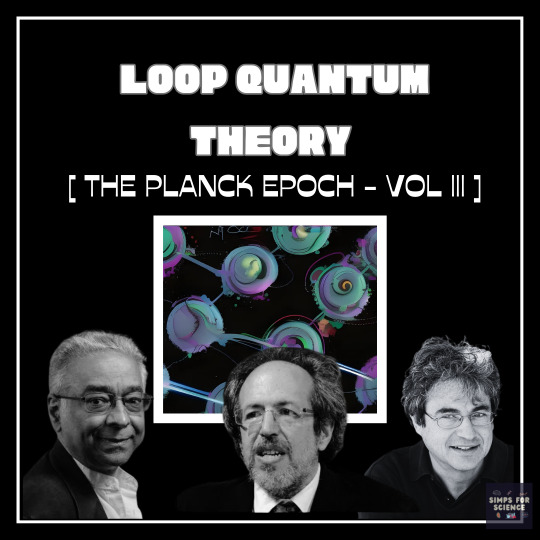
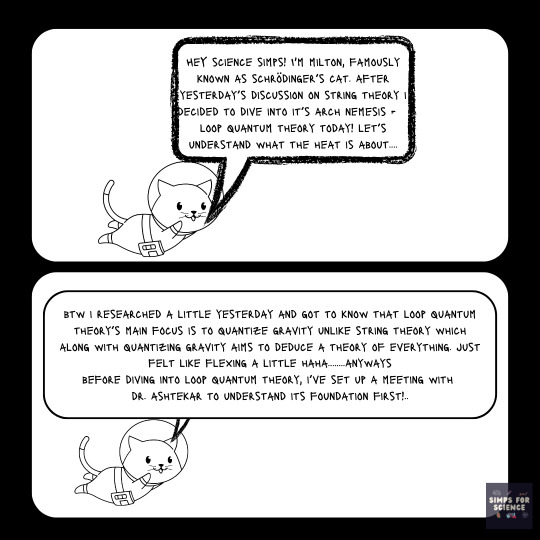
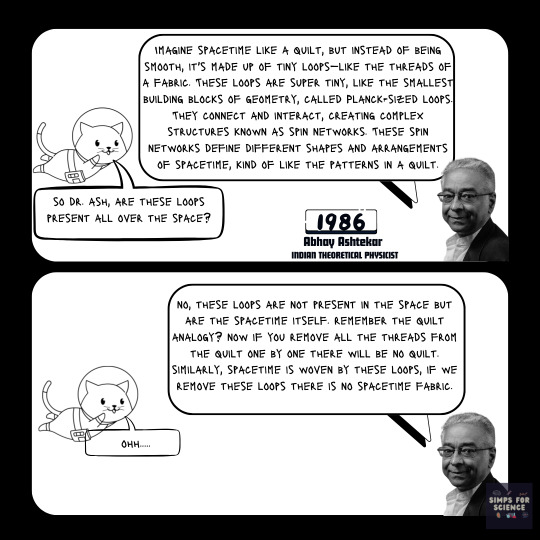
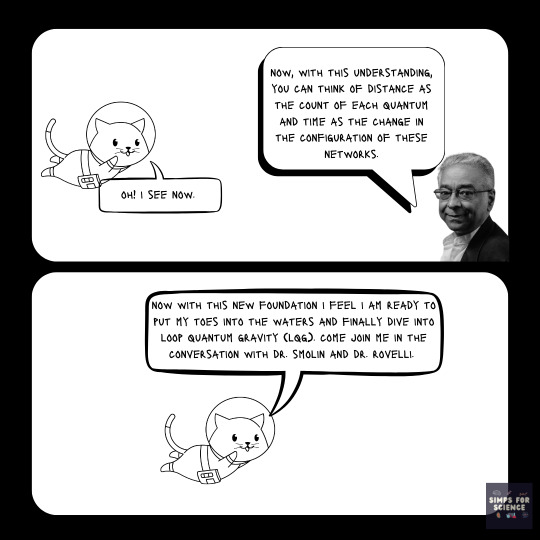
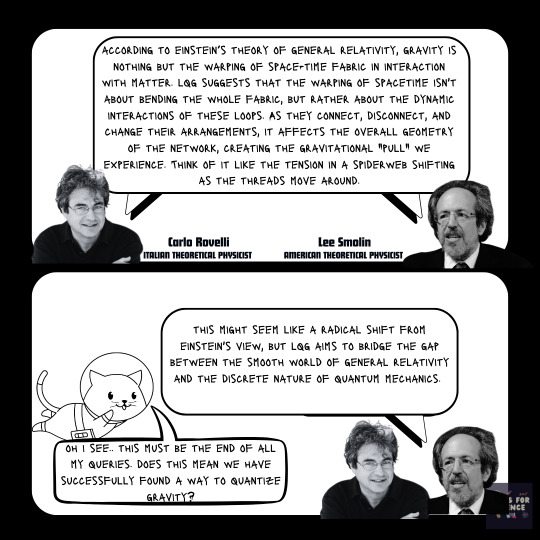
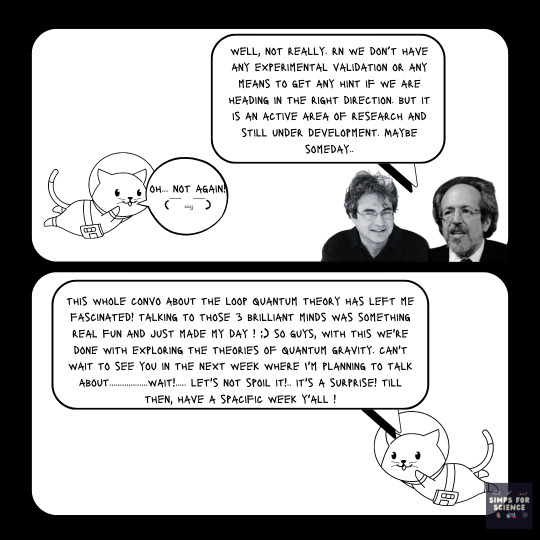
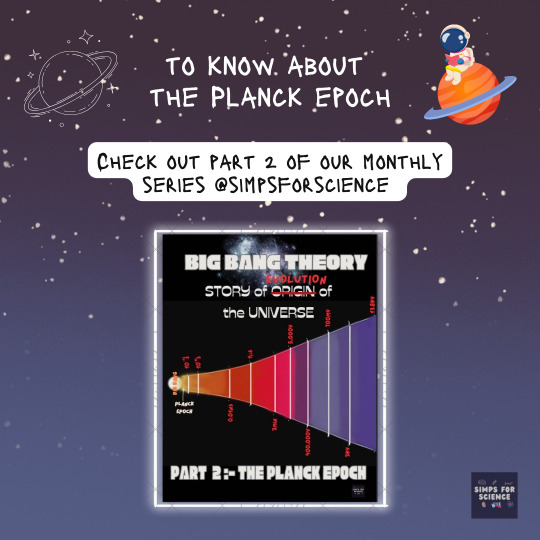
⁉️ What if you're told to forget smooth spacetime and imagine the universe as a cosmic quilt made up of loops? 💭 ➰ That's Loop Quantum Theory! which proposes that space itself is made of tiny, 🤏🏻 interconnected loops, ➿ a fabric of reality finer than any thread. Swipe ➡️ through this post to find how it is a potential quantum upgrade to Einstein's gravity, where the universe isn't just curved, it's knotted!🪢☄️🌠
📸 Image Credits:
Abhay Astekar :- PennState Eberly College of Science
Carlo Rovelli :- Foto LaPresse
Lee Smolin :- footnotes2plato
#loop quantum gravity#quantum mechanics#general relativity#quantum gravity#quantum physics#physics#physicist#astronomy#astrophysics#cosmos#comic art#comics#cosmology#space#nasa#planckepoch#max planck#education#science#science facts#discover#study blog#scicomm#explore#cool science#simps for science
15 notes
·
View notes
Text
By contrast, loop quantum gravity grew out of a tradition tightly grounded in the general theory of relativity; to most practitioners of this approach, gravity has always been the main focus.
"The Fabric of the Cosmos" - Brian Greene
#book quote#the fabric of the cosmos#brian greene#nonfiction#contrast#loop quantum gravity#general relativity#gravity
2 notes
·
View notes
Text
A Seahorse Tale ~ A Spin on the Matter of Motion
A Seahorse Tale ~ A Spin on the Matter of Motion is a young adult educational eBook cloaked as a sci-fi. Each of the 170 pages have beautifully illustrated art and science diagrams. Interwoven throughout the story are non-fiction links to various topics and state-of-the-art science, which corroborate the storyline and substantiate the possibility of the occurrence of these fantastical and…

View On WordPress
#art#biology#charter#Charter Schools#chemistry#DNA#Education#EL#EXL#expeditionary learning#experiential learning#holographic universe#home-school and autism spectrum students#homeschooling#leaning#magnet#mathematics#multidisciplinary#narrative#new story#physics#quantum loop gravity#quantum theory#Science#Spirals#Spirituality#Systems View#Tell the Truth#universe story#waves
0 notes
Text
Not Even Wrong: The Case Against String Theory
Peter Woit is a mathematician and physicist known for his work in quantum field theory and quantum gravity. He is a senior lecturer at Columbia University, where he has been involved in teaching and research for many years. His academic interests lie in the mathematical underpinnings of theoretical physics, particularly in understanding the fundamental forces and particles that make up the universe.
Woit is perhaps best known for his critical stance on string theory, a prominent theoretical framework that attempts to reconcile quantum mechanics with general relativity by proposing that the fundamental constituents of the universe are one-dimensional "strings" rather than point particles. Despite its popularity, string theory has faced criticism for several reasons. One of Woit's primary criticisms is that string theory has not produced any testable predictions that can be verified through experiments. This lack of empirical evidence makes it difficult to validate or falsify the theory. Additionally, Woit argues that string theory has led to a proliferation of possible solutions, known as the "landscape problem," where an enormous number of possible universes exist within the theory's framework. This makes it challenging to identify which, if any, correspond to our observed universe. Furthermore, Woit has expressed concern that the dominance of string theory has stifled alternative approaches to understanding fundamental physics, such as twistor theory and loop quantum gravity. Twistor theory, originally proposed by Roger Penrose, offers a mathematical framework that could potentially unify general relativity and quantum mechanics. Loop quantum gravity is another approach to quantum gravity that attempts to quantize spacetime itself without relying on strings.
The detailed critique of string theory in his book "Not Even Wrong" explores the history and development of theoretical physics. The title refers to a phrase attributed to physicist Wolfgang Pauli, describing theories that are so flawed they cannot even be considered incorrect. Woit argues that string theory fits this description due to its lack of testable predictions. He believes that fostering a diverse range of ideas and approaches is essential for advancing our understanding of fundamental physics and he hopes to inspire future breakthroughs in areas like quantum gravity and particle physics by encouraging open-mindedness and innovation.
Peter Woit: String Theory and the Crisis in Physics (Robinson Erhardt, September 2024)
youtube
Saturday, September 21, 2024
4 notes
·
View notes